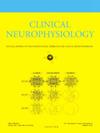Activation site estimation using induced current simulation and motor evoked potential latency in transcranial magnetic stimulation
IF 3.7
3区 医学
Q1 CLINICAL NEUROLOGY
引用次数: 0
Abstract
Objective
The exact part of the motor cortex activated by transcranial magnetic stimulation (TMS) remains debatable. This study investigates the electric field (EF) distribution induced by TMS coils in personalized head models, focusing on group-level evaluation considering motor-evoked potential (MEP) latency differences.
Methods
Thirteen healthy right-handed men (mean age 22.9 ± 1.04 years) participated in this study. Two TMS coils, Figure-of-8 (Fo8) and a double cone (DC), were employed to deliver single pulses at various coil positions. MEPs were recorded from the first dorsal interosseous muscle. The EF distribution was computed in personalized head models using finite-difference methods and mapped to the standard brain space.
Results
MEP latencies differed significantly between Fo8 and DC coils in seven participants but were similar in six. Group-level EF analysis revealed distinct activation patterns, with the highest EF strength in the crowns of the gyri. In cases with minimal MEP latency differences, EF–motor threshold correlation highlighted activation in the anterior wall of the central sulcus, consistent with fMRI studies.
Conclusions
Our findings underscore the variability in EF distribution across participants and coils, offering novel insights into the relationship between the EF and MEP latencies.
Significance
EF computation considering MEP latency differences may enable high-resolution imaging of the activation sites.
经颅磁刺激中感应电流模拟和运动诱发电位潜伏期的激活位点估计
目的经颅磁刺激(TMS)激活运动皮层的确切部位仍有争议。本研究探讨了经颅磁刺激线圈在个性化头部模型中诱发的电场分布,重点研究了考虑运动诱发电位(MEP)潜伏期差异的组水平评价。方法13例健康右撇子男性(平均年龄22.9±1.04岁)参加本研究。两个TMS线圈,fig -of-8 (Fo8)和一个双锥(DC),被用来在不同的线圈位置传递单脉冲。从第一背骨间肌记录mep。使用有限差分方法计算个性化头部模型的EF分布,并将其映射到标准脑空间。结果7名受试者的mep潜伏期在Fo8和DC线圈之间有显著差异,而6名受试者的mep潜伏期相似。群体水平的EF分析显示了不同的激活模式,脑回冠区EF强度最高。在MEP潜伏期差异最小的情况下,ef -运动阈值相关性突出了中央沟前壁的激活,与fMRI研究一致。我们的研究结果强调了EF分布在参与者和线圈之间的可变性,为EF和MEP潜伏期之间的关系提供了新的见解。考虑MEP潜伏期差异的ef计算可以实现激活位点的高分辨率成像。
本文章由计算机程序翻译,如有差异,请以英文原文为准。
求助全文
约1分钟内获得全文
求助全文
来源期刊

Clinical Neurophysiology
医学-临床神经学
CiteScore
8.70
自引率
6.40%
发文量
932
审稿时长
59 days
期刊介绍:
As of January 1999, The journal Electroencephalography and Clinical Neurophysiology, and its two sections Electromyography and Motor Control and Evoked Potentials have amalgamated to become this journal - Clinical Neurophysiology.
Clinical Neurophysiology is the official journal of the International Federation of Clinical Neurophysiology, the Brazilian Society of Clinical Neurophysiology, the Czech Society of Clinical Neurophysiology, the Italian Clinical Neurophysiology Society and the International Society of Intraoperative Neurophysiology.The journal is dedicated to fostering research and disseminating information on all aspects of both normal and abnormal functioning of the nervous system. The key aim of the publication is to disseminate scholarly reports on the pathophysiology underlying diseases of the central and peripheral nervous system of human patients. Clinical trials that use neurophysiological measures to document change are encouraged, as are manuscripts reporting data on integrated neuroimaging of central nervous function including, but not limited to, functional MRI, MEG, EEG, PET and other neuroimaging modalities.
 求助内容:
求助内容: 应助结果提醒方式:
应助结果提醒方式:


